Build-A-Rig Round 1, Zotac vs. Corsair: The $1500 PC Showdown
by Ryan Smith on August 5, 2015 6:00 AM EST- Posted in
- Build-A-Rig
- Systems
- Corsair
- ZOTAC
Gaming Performance
Shifting gears to gaming performance, and the focus of our $1500 Build-A-Rig challenge builds, the GPU becomes a much greater factor here, as these tests will shift between being CPU limited at lower resolutions and outright GPU limited at higher resolutions. As a reminder, Zotac went with one of their factory overclocked GeForce GTX 970 cards, while Corsair went with a Zotac reference GeForce GTX 980 Ti. Meanwhile the theoretical GPU performance difference between the two systems is greater than their CPU differences, however resolution will be an important factor here. Ultimately the Corsair system was designed to focus on 1440p and 4K gaming while the Zotac was not, so we’ve structured our testing accordingly.
We’ll start off our look at gaming performance then with our synthetic 3DMark gaming benchmarks. When working across vendors these benchmarks can be a little more problematic, but since both systems are using GeForce GTX 900 series cards, we should get some reliable results for how the gaming performance of the two systems differs.
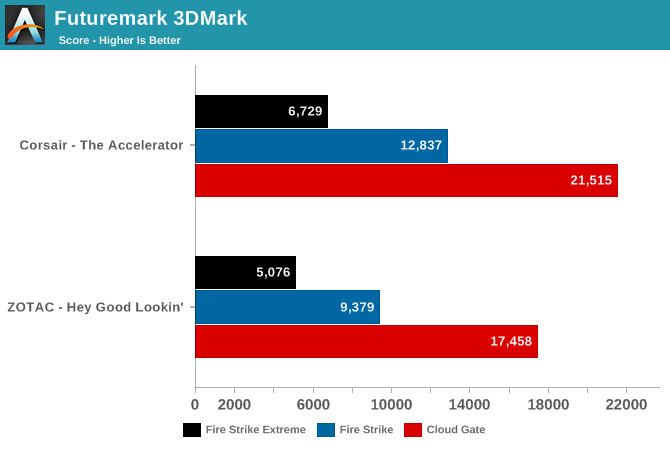
The latest version of 3DMark puts the Corsair system solidly in the lead. The actual lead depends on the sub-test used, but on the more aggressive tests the Corsair system enjoys a 30-35% lead over the Zotac system.

The story is much the same with the older 3DMark 11. Once we crank up the test settings to something more befitting of these high-end GPUs, the Corsair system holds a lead of around 34%. However it’s interesting to note that the significant factory overclock on the Zotac GTX 970 and its ability to better avert thermal throttling means that these cards are closer than a cursory look at specifications might suggest.
Moving on to our real world gaming benchmarks, we’ll start with The Talos Principle. Croteam’s first person puzzle and exploration game The Talos Principle may not involve much action, but the game’s lush environments still put even fast video cards to good use. Coupled with the use of 4x MSAA at Ultra quality, and even a tranquil puzzle game like Talos can make a good case for more powerful video cards.

On our first real world game benchmark the Corsair system starts out especially strong here. The performance advantage for Corsair’s system is nearly 50% at both 1080p and 1440p, something of a best case scenario for both cards. In either case, the Zotac system can easily average 60fps at 1440p, hitting Zotac’s goals, while the Corsair system can’t quite hit 60fps at 4K, but still delivers more than playable performance for the rigors of such a high resolution.
Moving on, Total War: Attila is the latest game in the Total War franchise. Total War games have traditionally been a mix of CPU and GPU bottlenecks, so it takes a good system on both ends of the equation to do well here. In this case the game comes with a built-in benchmark that plays out over a large area with a fortress in the middle, making it a good GPU stress test.
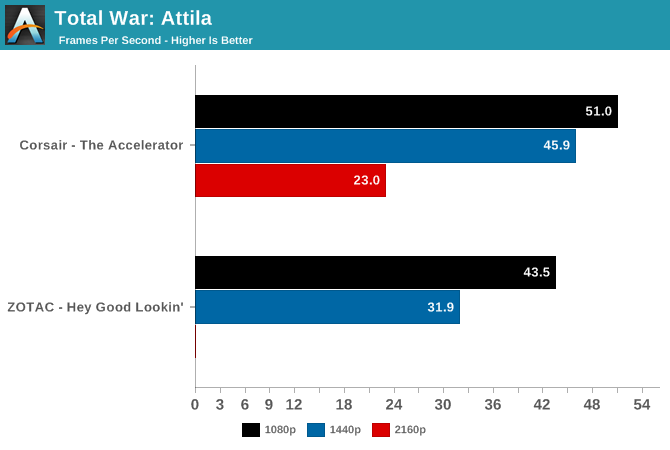
Attila is a great example of how one can be both CPU and GPU limited, especially when shifting resolutions. At 1080p the Corsair system is still in the lead, but not by much – we’re being held back by the CPU at times in this benchmark at this resolution. However shift to 1440p and the difference between the two systems opens up as it becomes much more strongly GPU-limited. In any case we’re not going to cross 60fps at any time with these settings regardless of the GPU, but since this is a strategy game 30fps is a more reasonable target.
For the racing game in our benchmark suite we have Codemasters’ GRID Autosport. Codemasters continues to set the bar for graphical fidelity in racing games, delivering realistic looking environments with layed with additional graphical effects. Based on their in-house EGO engine, GRID Autosport includes a DirectCompute based advanced lighting system in its highest quality settings, which incurs a significant performance penalty on lower-end cards but does a good job of emulating more realistic lighting within the game world.
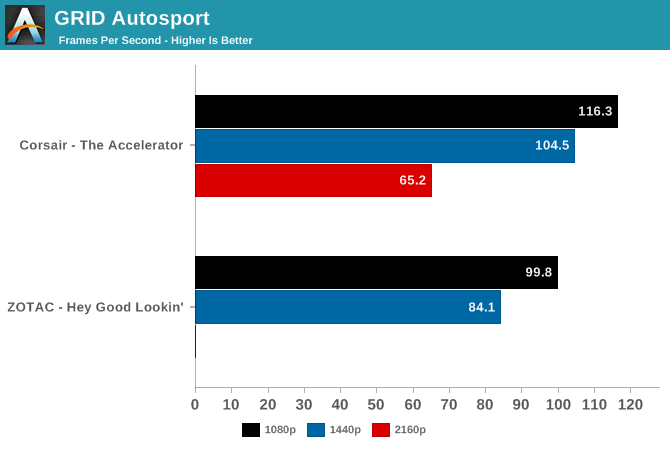
GRID is another game where we end up CPU limited at lower resolutions; it doesn’t manifest itself too strongly, but I suspect the difference in performance between the Corsair and Zotac systems at 1080p is more CPU driven than GPU driven. Which is why the performance difference between the two systems opens up a bit more at 1440p.
Up next we have Crysis 3. With Crysis 3, Crytek has gone back to trying to kill computers and still holds the “most punishing shooter” title in our benchmark suite.
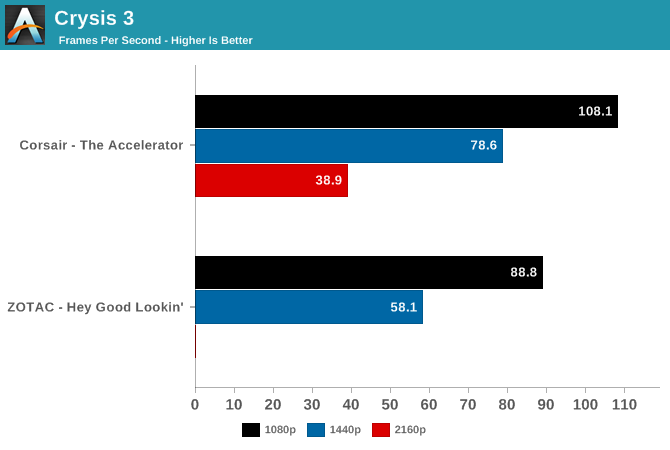
A more pure GPU benchmark in our test suite, Crysis 3 puts the Corsair system ahead by 35% at 1440p. However in the process the Zotac system fares rather well for itself; the average framerate of 58fps being just shy of 60fps, so overall the Zotac system is still hitting its marks. What it can’t do is run at 4K, not that the Corsair system does exceptionally well either due to the strain of pushing so many pixels.
The final game in our benchmark suite is Grand Theft Auto V. The latest edition of Rockstar’s venerable series of open world action games, Grand Theft Auto V was originally released to the last-gen consoles back in 2013. However thanks to a rather significant facelift for the current-gen consoles and PCs, along with the ability to greatly turn up rendering distances and add other features like MSAA and more realistic shadows, the end result is a game that is still among the most stressful of our benchmarks when all of its features are turned up.
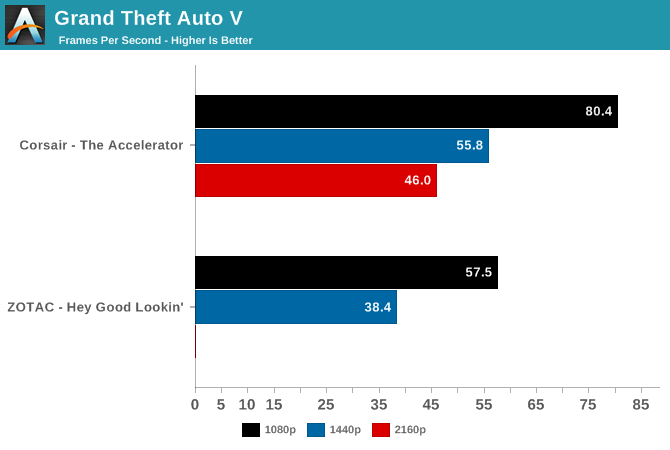
GTA V is another significant GPU stressor, resulting in the Corsair system taking a significant 40%+ lead here. Overall at these settings the Zotac system is going to be better off at 1080p, while the Corsair system can handle 1440p. Though even with its extra power, the Corsair system is struggling a bit with 4K, with a 46fps frame rate offering a bit less performance than what’s necessary for PC-standard smoothness.
Finally, while looking at gaming performance we’re also taking a look at GPU compute performance via CompuBench 1.5. Backed by OpenCL, we’ve picked out three of the benchmark’s suites best sub-tests, highlighting different use cases for GPU compute in modern systems.
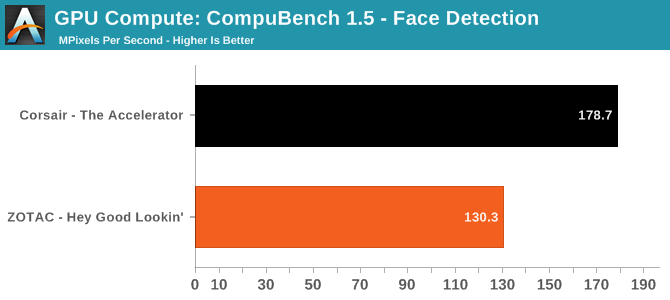
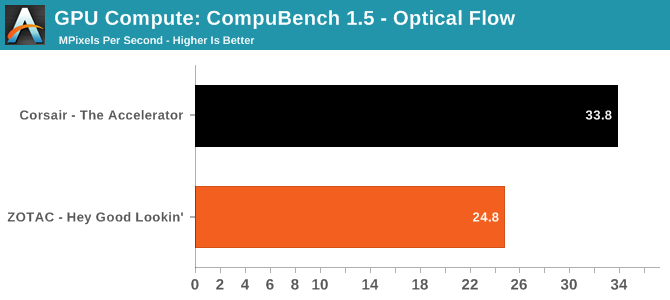
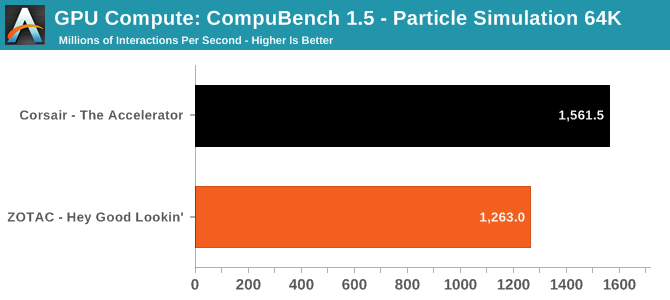
Overall the Corsair system retains a solid lead. How big of a lead varies with the sub-test, but it’s at least 20% across all of these sub-tests.










21 Comments
View All Comments
heffeque - Wednesday, August 5, 2015 - link
I'd stay with Zotac's build, even though it doesn't perform as well as Corsair's build.a1exh - Wednesday, August 5, 2015 - link
But it has a Z79 motherboard ;)Ryan Smith - Wednesday, August 5, 2015 - link
What'chu talkin' 'bout, Willis? ;)AndrewJacksonZA - Wednesday, August 5, 2015 - link
He's talking about "Die Harder." ;-)a1exh - Wednesday, August 5, 2015 - link
They had a typo but it's sneakily been fixed.AndrewJacksonZA - Wednesday, August 5, 2015 - link
Congratulations Dustin, you chalked up a win in my book. :-)nedge2k - Wednesday, August 5, 2015 - link
I'd like to see a HTPC gaming rig build-off. Only stipulations being the case must be able to take the place of a DVD player (i.e. no towers or shuttles) and it must have a least a dual TV tuner. Oh and a VFD/OLED display would be a bonus.HOOfan 1 - Wednesday, August 5, 2015 - link
Chinny went a little overboard on the CPU cooler and Power Supply, and then spent money on bling instead of more RAM and a better graphics card.BrokenCrayons - Wednesday, August 5, 2015 - link
I think it's a really classy sort of bling that doesn't go over the top at all.Gigaplex - Wednesday, August 5, 2015 - link
LED strips are over the top.